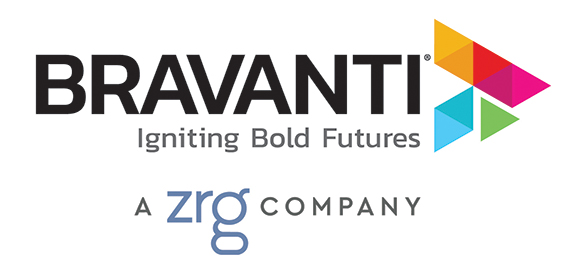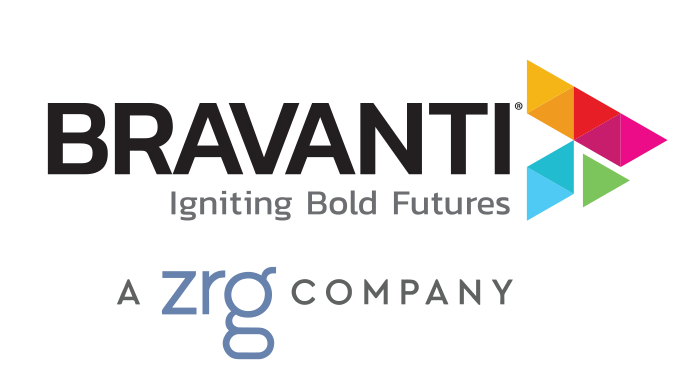By Bravanti
The talent function is one of the fastest evolving functions in businesses today. Bringing an abundance of workforce insights, talent development knowledge, and cultural awareness to the table, the impact of HR in organizational success has evolved from peripheral to pivotal.
Enter the talent strategy, one of your organization’s greatest assets. In fact, how you structure, hire, develop, and engage your workforce can be the critical leverage point that sets your organization apart in the race for top talent. With the constant rate of change, what does a modern talent strategy look like, and how can businesses more effectively use it to achieve organizational objectives?
Here are six key elements of a high-performing talent strategy to help ensure that you have the right people with the right skills in the right roles at the right time to drive business results.
1. Align Talent Strategy Initiatives to Business Objectives
Business and talent initiatives both need executive buy-in to succeed. Yet, despite this mutual dependency, establishing a symbiotic relationship between revenue and talent is historically challenging.
In recent years, however, companies have begun to align business strategy with people strategy. What exactly does this mean? If a company seeks to grow through acquisition in new markets, it needs to ensure that it has the right talent in place to make this happen. If its employee population lacks significant M&A and global experience, then it needs to close these gaps through development and intentional experience. Why does this matter? There is definitive evidence that, without aligned talent strategies, everything from mergers, global expansions, and product launches to day-to-day operations fail to meet expectations.
Simply having an awareness of long-term initiatives isn’t enough. Today’s top talent leaders partner with everyone from the C-suite to department heads, regional leaders, etc. to develop targeted talent strategies based on functional, local, and focused needs.
Put it into practice:
- Get involved. Whether you’re planning a merger, preparing for a potential economic downturn, or simply pursuing best practices, injecting HR into strategic conversations early in the process is important. Even if HR is not actively playing a role in a planned change, maintaining situational awareness to recognize the change’s implications to your talent strategy will help ensure alignment from the onset.
- Use internal analytics to help you articulate the people strategy. HR has unique insight into current and future talent strengths, weaknesses, opportunities, and threats. Use this knowledge to help align and guide business objectives.
- Emphasize culture as a primary driver in achieving organizational goals. Culture is so much more than simply workforce morale and feel-good team building. Culture is how work gets done and encompasses everything: attitudes toward change, leadership styles, professional development, workplace equality, how employees treat each other, how decisions are made, and so much more. Illustrate the bottom-line benefits of prioritizing culture and watch C-suite buy-in grow.
2. Incorporate Succession Planning into Your Talent Strategy
Are leadership gaps keeping you up at night? You have a lot of company. According to a Deloitte succession study, 86% of leaders believe leadership succession planning is an “urgent” or “important” priority, yet only 14% believe they do it well.
While you can’t change individual career decisions, you can account for leadership departures via long-tailed succession plans and accelerated leadership development programs and experiences.
Succession planning can be difficult for a number of reasons, but it doesn’t have to be the so-called elephant in the room with senior leadership. With proper integration into the overall business and talent strategy, you can establish succession planning as a natural, proactive component of each leadership role.
Another key component of succession planning is keeping the talent pipeline full. Today’s workforce expects professional development opportunities that surpass typical training and development programs. Clearly articulating growth and advancement opportunities – and nurturing a learning environment – will help to maintain a strong, engaged pipeline from which to build your succession planning.
Put it into practice:
- Early need identification is key. Establish a regular meeting with leadership to identify confirmed and potential departures for a rolling period of time (e.g., 12 months).
- Enlist the support of departing leaders. When possible, consider enlisting your departing leaders to help build the succession game plans. Their insights are invaluable and can often streamline the process of identifying potential replacements and possibly allow for interim mentoring to ease the transition.
- Maintain a talent pipeline. For key roles within the organization, you’ll likely need to keep a pipeline of high-potentials. Build this pipeline based on the co-developed succession game plan and iterate as needed and with each succession.
3. Prepare for the Worst, Build for the Best
No matter how much advance warning you have, change can devastate even the most well-intentioned strategy if it doesn’t realistically account for the “what ifs?”
Planning for contingencies in your talent strategy is critical to protecting your organization from negative effects of change. After all, your workforce is the foundation for organizational success and your ability to attract and retain top talent during tough times can be the key to thriving while others flail.
Put it into practice:
- Be a realist. If you don’t know something is a threat, how can you address it? Work with organizational leaders to identify internal and external factors, as well as the potential impacts on the business, and develop a talent strategy that minimizes threats while capitalizing on opportunities. This requires honest conversations around threats and weaknesses but will help to ensure your talent strategy isn’t created in a vacuum.
- Keep employees engaged and informed. We can’t overemphasize the power of an engaged workforce. Treating your employees as partners in your organization’s success will garner buy-in that, if properly maintained in both good times and bad, can be a growth catalyst in times of change. A large part of this is transparency: your workforce knows when something’s “up” and secrecy only breeds fear and mistrust. Lead with transparency wherever possible to maintain morale and employee confidence during turbulent times.
- Create and maintain contingency plans. While never pleasant to create, establishing contingency plans during good times will ensure that the chaos of change doesn’t lead to inadequate or poor actions that haunt your organization long after the contingency has passed.
4. Find (and Use) a Reliable Talent Partner
We’ve all daydreamed about what we could do with just a few more hours in the day. Maybe you would finally kick-start that new initiative or optimize daily operations to improve team productivity. Sometimes, it would be nice to just complete your to-do list!
But the learning and development landscape is evolving at warp speed, along with employee engagement trends, compensation demands, workforce technology needs, and a host of other “focus” areas, often leaving us just enough time to (hopefully) check the box with little room for optimization.
While a talent partner can’t give you more hours in the day, they can give you expertise and perspective to help you accelerate decision-making, inform strategic direction, and advise on environmental factors you might otherwise miss.
Put it into practice:
- Identify your needs. Whether you’re kicking off a new initiative or a specific area of contention is impeding progress, consider the areas of your talent strategy where an outside perspective could provide the insights needed to move forward with confidence.
- Outline your requirements. Once you’ve identified your needs, you can begin to determine the type of learning and development partnership that will work best for you and your organization. Consider expertise areas, service offerings, reputation, available resources, and compatibility to ensure a successful partnership.
- Reach out to your network. One of your greatest resources is your professional network, and you can almost guarantee that someone you know either directly or indirectly has lessons learned to share with you. Don’t be afraid to tap into that knowledge source for first-hand use-case scenarios. What was the challenge? What process was used to source adequate support? How did that support move the initiative forward?
5. Cultivate In-Demand, Under-Developed Soft Skills in Your Talent Strategy
While Millennials and Gen Z bring new ideas, refreshing energy, and an impressive cache of technical skills to the workforce, there’s a growing body of evidence indicating that critical soft skills like problem solving, collaboration, learnability, and time management are largely under-developed in these generations. Even the U.S. Chamber of Commerce Foundation actively monitors this soft skills deficit. But, while there appear to be a number of leading factors in the skills shortage, the overwhelming consensus is this: these soft skills are in high demand yet remain largely elusive.
What’s the solution? In addition to recruiting for these specific skill sets, you must incorporate soft skills training into your talent development plans. If you are fortunate enough to have the time, resources, and executive buy-in to create new modules for soft skills training, all the better! However, there are brilliant ways of working the soft skills development into your existing programs.
Put it into practice:
- Conduct assessments to establish leadership skill set benchmarks. What skills are most valuable? How do you measure success?
- Build mentor programs. The benefits of mentoring opportunities are undeniable and are shown to accelerate soft skills development while simultaneously preparing individual contributors for leadership roles.
- Incorporate flipped learning into your training programs. Presenting core concepts, followed by hands-on application, helps to accelerate team skills development through peer-driven learning environments.
6. Accelerate Leadership Development via Senior Leader Coaching
It’s only natural to want to replicate and scale great coaching results, which is likely why organizations today are scrambling to introduce one-on-one coaching to more tactical leadership levels throughout their organizations.
Yes, gone are the days of C-suites reaping all the benefits of one-on-one coaching. Hyper-competitive employment markets and the demand for accelerated leadership development begs a new approach. Hence the palpable shift toward senior leader coaching.
Put it into practice:
- Establish desired outcomes. Naturally, the coaching outcomes for senior leaders will differ from that of executive leaders. Partner with leaders at all levels in your organization to identify what skill sets, leadership traits, management styles, etc. your senior leader coaching program will target.
- Find a reliable partner. As your secret L&D weapon, your senior leader coaching program should be developed according to best practices, industry standards, and proven results. Given that senior leader coaching is a fairly new take on the well-established world of executive coaching, partnering with an expert can help to launch your program faster and better.
- Integrate with existing high-potential programs. If you already have high-potential leader programs, integrating one-on-one senior leader coaching into the mix can be the high-quality touch that takes your program to the next level.
Regardless of your industry, structure, or company size, your talent strategy is the foundation for organizational success. Your people are your greatest resource and a well-rounded strategy helps to guide every step of hiring, onboarding, developing, and engaging that workforce for sustainable growth and success. These six elements will ensure that your talent strategy is created for success in 2020 and beyond.

